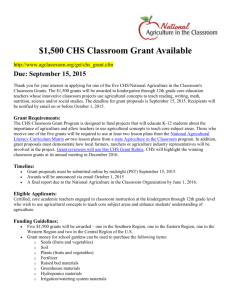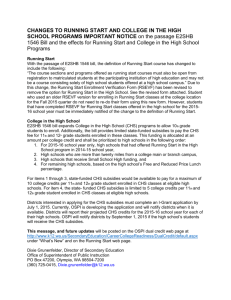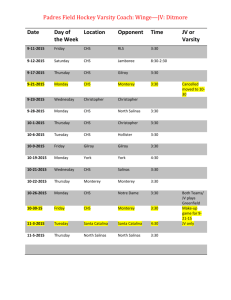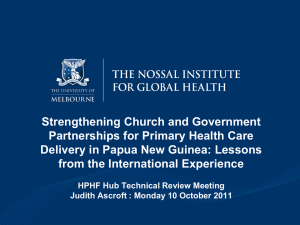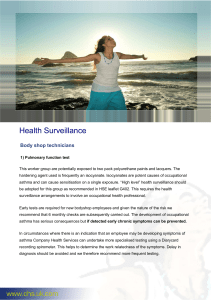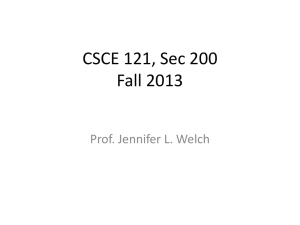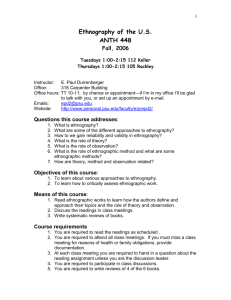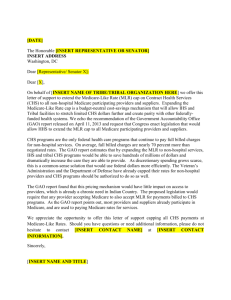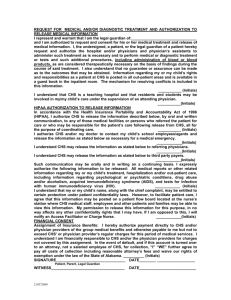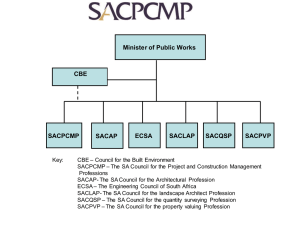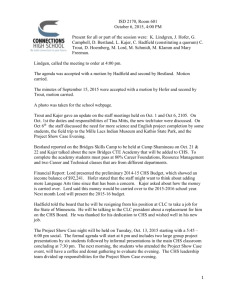Programme
advertisement
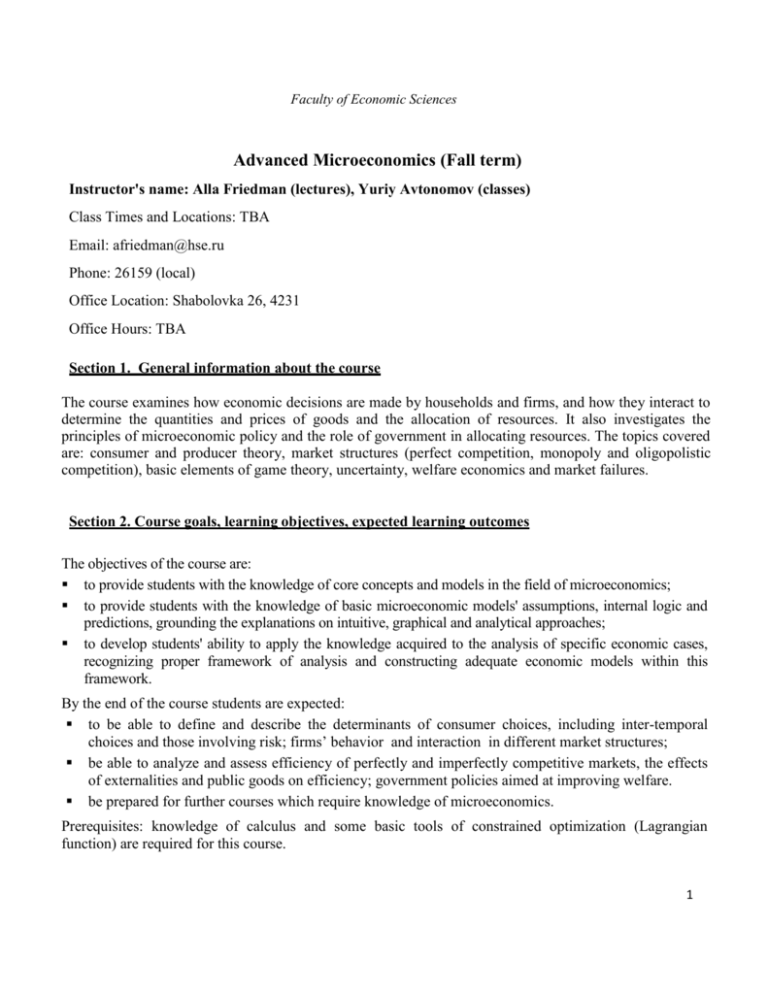
Faculty of Economic Sciences Advanced Microeconomics (Fall term) Instructor's name: Alla Friedman (lectures), Yuriy Avtonomov (classes) Class Times and Locations: TBA Email: afriedman@hse.ru Phone: 26159 (local) Office Location: Shabolovka 26, 4231 Office Hours: TBA Section 1. General information about the course The course examines how economic decisions are made by households and firms, and how they interact to determine the quantities and prices of goods and the allocation of resources. It also investigates the principles of microeconomic policy and the role of government in allocating resources. The topics covered are: consumer and producer theory, market structures (perfect competition, monopoly and oligopolistic competition), basic elements of game theory, uncertainty, welfare economics and market failures. Section 2. Course goals, learning objectives, expected learning outcomes The objectives of the course are: to provide students with the knowledge of core concepts and models in the field of microeconomics; to provide students with the knowledge of basic microeconomic models' assumptions, internal logic and predictions, grounding the explanations on intuitive, graphical and analytical approaches; to develop students' ability to apply the knowledge acquired to the analysis of specific economic cases, recognizing proper framework of analysis and constructing adequate economic models within this framework. By the end of the course students are expected: to be able to define and describe the determinants of consumer choices, including inter-temporal choices and those involving risk; firms’ behavior and interaction in different market structures; be able to analyze and assess efficiency of perfectly and imperfectly competitive markets, the effects of externalities and public goods on efficiency; government policies aimed at improving welfare. be prepared for further courses which require knowledge of microeconomics. Prerequisites: knowledge of calculus and some basic tools of constrained optimization (Lagrangian function) are required for this course. 1 Week Section 3. Course Outline Course format Readings № Topic/Focus/Activity 1 Consumer theory: preferences and utility, budget constraint, consumer choice demand and comparative statics, Slutsky decomposition choice under in-kind income, labour supply and intertemporal choice consumer surplus 2 4-5 Choice under uncertainty contingent commodities expected utility and attitude toward risk choice under uncertainty demand for insurance demand for risky asset price of information 6 3 10 P&R Ch. 5 V. Ch. 12 3 Producer theory 5-7 technologies and their properties cost minimization (SR and LR) profit maximization and firm’s supply 7-9 Perfectly competitive market 8 4 14 P&R Chs. 6-8 V. Chs.18-22 8 4 16 P&R Chs. 8-9, 14.1 V. Chs. 15-16, 23 6 3 12 P&R Chs. 10-11, 14.3-14.4 V. Chs.24-25 4 5 1-3 lectures classes self-study 12 6 20 P&R Chs. 3-4, 14.2 V. Chs. 2-10, 14 market demand industry supply partial equilibrium and efficiency government policies analysis Monopoly and monopolistic behavior pure monopoly inefficiency and regulation monopsony price discrimination (perfect discrimination, market segmentation, example of seconddegree price discrimination) 9-10 2 6 11-12 8 Strategic interactions basic concepts of game theory (dominant strategies, Nash equilibrium, dynamic games and subgame perfect Nash equilibrium) simultaneous quantity competition (Cournot model) first-mover advantage in Stackelberg model price competition (Bertrand model) 4 14 P&R Chs. 12-13 V. Chs.27-29 7 13-14 8 Externalities and public goods externalities and efficiency loss regulation (direct regulation, taxes/subsidies, tradable permits; internalization, property rights and Coase theorem) common property resources public goods and efficiency free riding problem 4 14 P&R Ch. 18 V. Chs. 34, 36 8 15-16 8 Asymmetric information hidden characteristics and adverse selection private and government response hidden action and moral hazard problem 4 16 P&R Ch. 17 V. Ch. 37 Description of course methodology and forms of assessment to be used While teaching the course the following teaching methods and forms of study and control are used: lectures (4 hours a week); classes (2 hours a week); written home assignments; written in-class quizzes; self-study; teachers’ consultations; written test Aassessment and grade determination: Average mark for home assignments Average quiz mark Closed-book test [25%] [25%] [50%] 3 Section 4. Texts, readings and other informational resources 1. Required readings: Varian Hal R., Intermediate Microeconomics: A Modern Approach, W. W. Norton & Company; Eighth Edition edition, 2009 [V] Pindyck Robert S., Daniel L. Rubinfeld, Microeconomics, 8th Edition, Pearson Series in Economics, 2013.[P&R] 2. Additional readings (more advanced textbook) Varian H., Microeconomic Analysis, 3rd edition, W.W.Norton &Company, New York, London, 1992. Section 5. Examination/Evaluation Sample test 1. Short questions [8 points each] (a) “Risk-loving person always gambles.” True or false? (Provide a proof if you think that the statement is correct and propose a counterexample otherwise). (b) Consider a firm with the following cost function С Q Q 2 3Q 25 . Find the long-run supply and the shortrun supply of the firm, under the assumptions that the total cost function is the same in the long and in the shortrun, but the fixed cost is sunk in the short run. (c) Consider a perfectly competitive industry. Is it true that a per unit subsidy increases economic efficiency? (d) A person responds to increase in the rate of interest by first increasing his saving and then (with further increases in the interest rate) reducing his saving. Is he necessarily irrational? Explain. (e) If insurance companies cannot observe the type (riskiness) of potential insurance policyholders, the usual competitive market supply logic of selling more insurance packages at a higher price does not always hold. Is this true or false? Explain your answer. (f) With an external cost in production, is society clearly better-off under perfect competition than under a monopoly in that industry? 2. [26 points] Consider an industry with inverse market demand P(Q) 22 Q . There are two firms: firm A has cost function C A q A 2q A and firm B has cost function CB qB 6qB . (a) Find the Cournot equilibrium. Illustrate graphically. (b) Now consider a three-stage game, where firm A moves first, then at second stage firm B observes the output of firm A and chooses its own output, finally at stage 3 firm A can change its mind about how much to produce and makes a final output decision. Find equilibrium. Compare the resulting profits with part (a) and explain the difference. Provide graphical solution using diagram from (a). (c) Calculate the value of deadweight loss in (a) and (b). Compare and explain the reasons for inefficiency. 3. [26 points] A firm that specializes in import of used cars decided to insure its cargo. At present the assets of the firm are valued at $1 million (you may think that the wealth of the firm’s owner is equal to the value of the firm’s assets). The value of the cargo is $100 thousands. Suppose that utility function of the firm’s owner is uw e bw , where b>0 and w stays for his wealth. 4 (a) It was observed that the firm purchased full insurance against the losses of its cargo and $5000 was paid for this insurance contract. How does this firm assess the probability of an accident? (b) Suppose that probability of an accident is 1. Assume that insurance company is risk neutral and has zero operation cost. Suppose that insurance contract specifies the insurance coverage denoted by X and the price of the contract P (the sum paid by the cargo owner to the insurance company). Illustrate all mutually beneficial contracts in contingent commodities space. . (c) Suppose that the insurance company considered in (b) is the only company that is willing to insure this cargo. Find the optimal insurance contract offered by this monopolist. Provide both graphical and analytical solutions. Explain the result intuitively. Grading system and how both the course and final test will be graded Written test is graded out of 100 points. Then the results for the written test, home assignments and quizzes are used to calculate the final mark using the weights specified in section 3 and the resulting mark is converted into 10-points scale. Make-up policies and form of the make-up There is one written make-up exam in the end of January/beginning of February set in accordance with the HSE’s Internal Regulations. Policies on late work Late home assignments are marked but are not counted for the average mark for home assignments. Section 6. Academic Integrity The Higher School of Economics strictly adheres to the principle of academic integrity and honesty. Accordingly, in this course there will be a zero-tolerance policy toward academic dishonesty. This includes, but is not limited to, cheating, plagiarism (including failure to properly cite sources), fabricating citations or information, tampering with other students’ work, and presenting a part of or the entirety of another person’s work as your own. HSE uses an automated plagiarism-detection system to ensure the originality of students’ work. Students who violate university rules on academic honesty will face disciplinary consequences, which, depending on the severity of the offense, may include having points deducted on a specific assignment, receiving a failing grade for the course, being expelled from the university, or other measures specified in HSE’s Internal Regulations. 5

